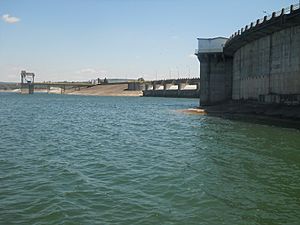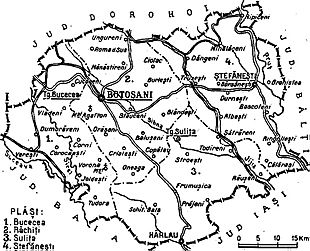Botoșani County facts for kids
Quick facts for kids
Botoșani County
Județul Botoșani
|
||
|---|---|---|
|
County
|
||
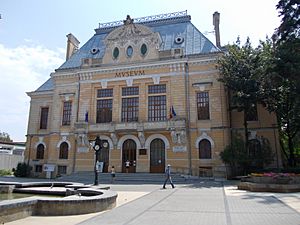
Former Botoșani County Prefecture
|
||
|
||
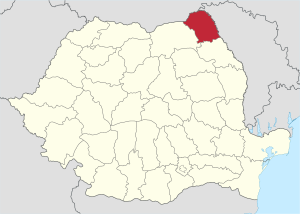
Location of Botoșani County in Romania
|
||
| Country | ||
| Development region1 | Nord-Est | |
| Historic region | Moldavia | |
| Capital city (Reședință de județ) | Botoșani | |
| Government | ||
| • Type | County Council | |
| Area | ||
| • Total | 4,986 km2 (1,925 sq mi) | |
| Area rank | 29th in Romania | |
| Population
(2021-12-01)
|
||
| • Total | 392,821 | |
| • Rank | 22nd in Romania | |
| • Density | 78.785/km2 (204.052/sq mi) | |
| Time zone | UTC+2 (EET) | |
| • Summer (DST) | UTC+3 (EEST) | |
| Postal Code |
71wxyz3
|
|
| Area code(s) | +40 x314 | |
| Car Plates | BT5 | |
| GDP | US$1.726 billion (2015) | |
| GDP per capita | US$4,18 (2015) | |
| Website | County Council County Prefecture |
|
| 1 as of 2007, the Prefect is not a politician, but a public functionary. He (or she) is not allowed to be a member of a political party, and is banned to have any political activity in the first six months after the resignation (or exclusion) from the public functionary corps 2w, x, y, and z are digits that indicate the city, the street, part of the street, or even the building of the address 3x is a digit indicating the operator: 2 for the former national operator, Romtelecom, and 3 for the other ground telephone networks 4used on both the plates of the vehicles that operate only in the county limits (like utility vehicles, ATVs, etc.), and the ones used outside the county |
||
Botoșani County (Romanian pronunciation: [botoˈʃanʲ]) is a county in Romania. It is located in the northeastern part of the country. The main city and capital of the county is Botoșani. This area is part of a larger historical region called Moldavia.
Contents
People of Botoșani County
As of 2011, Botoșani County had about 412,626 people living there. This means there were about 83 people for every square kilometer.
Most people in Botoșani County are Romanians. There are also smaller groups of Romani, Ukrainians, and Lipovans.
| Year | County population |
|---|---|
| 1948 | 385,236 |
| 1956 | 428,050 |
| 1966 | 452,406 |
| 1977 | 451,217 |
| 1992 | 458,904 |
| 2002 | 452,834 |
| 2011 | 412,626 |
| 2021 | 392,821 |
Where is Botoșani County?
Botoșani County is in the northeast of Romania. It lies between two important rivers, the Siret and the Prut.
- It shares a border with Ukraine to the north.
- To the east, it borders Moldova.
- On its western side, you'll find Suceava County.
- To the south, it borders Iași County.
The county covers an area of about 4,986 square kilometers. This is about 2.1% of Romania's total land. The land here is mostly a high plain. The climate is temperate, meaning it has mild temperatures.
What is the Economy Like?
Botoșani County is mainly an agricultural area. This means farming is a very important activity here.
However, there are also several industries:
- Textile industry: Making clothes and fabrics.
- Food industry: Processing food products.
- Electrical components industry: Making parts for electronic devices.
- Glass and porcelain industry: Producing items made of glass and porcelain.
One of the biggest hydroelectric power plants in Romania is located here. It's called the Stânca–Costești Hydroelectric Power Station. It was built between 1973 and 1978. This power plant works with the Stânca-Costești Dam, both built on the Prut River.
How is Botoșani County Organized?
Botoșani County is divided into different types of areas for administration. It has:
- 2 large cities called municipalities.
- 5 smaller towns.
- 71 communes, which are groups of villages.
Main Cities (Municipalities)
- Botoșani: This is the capital city of the county. In 2011, it had about 106,847 people.
- Dorohoi
Towns
- Bucecea
- Darabani
- Flămânzi
- Săveni
- Ștefănești
Communes
- Adășeni
- Albești
- Avrămeni
- Bălușeni
- Blândești
- Brăești
- Broscăuți
- Călărași
- Cândești
- Concești
- Copălău
- Cordăreni
- Corlăteni
- Corni
- Coșula
- Coțușca
- Cristești
- Cristinești
- Curtești
- Dersca
- Dângeni
- Dimăcheni
- Dobârceni
- Drăgușeni
- Durnești
- Frumușica
- George Enescu
- Gorbănești
- Havârna
- Hănești
- Hilișeu-Horia
- Hlipiceni
- Hudești
- Ibănești
- Leorda
- Lozna
- Lunca
- Manoleasa
- Mihai Eminescu
- Mihăileni
- Mihălășeni
- Mileanca
- Mitoc
- Nicșeni
- Păltiniș
- Pomârla
- Prăjeni
- Rădăuți-Prut
- Răchiți
- Răuseni
- Ripiceni
- Roma
- Românești
- Santa Mare
- Stăuceni
- Suharău
- Sulița
- Șendriceni
- Știubieni
- Todireni
- Trușești
- Tudora
- Ungureni
- Unțeni
- Văculești
- Viișoara
- Vârfu Câmpului
- Vlădeni
- Vlăsinești
- Vorniceni
- Vorona
Botoșani in the Past
|
Județul Botoșani
|
||
|---|---|---|
|
County (Județ)
|
||

The Botoșani County Prefecture building from the interwar period, currently the county museum.
|
||
|
||
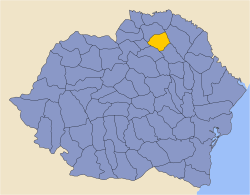 |
||
| Country | ||
| Historic region | Moldavia | |
| Capital city (Reședință de județ) | Botoșani | |
| Area | ||
| • Total | 3,077 km2 (1,188 sq mi) | |
| Population
(1930)
|
||
| • Total | 218,258 | |
| • Density | 70.932/km2 (183.713/sq mi) | |
| Time zone | UTC+2 (EET) | |
| • Summer (DST) | UTC+3 (EEST) | |
Between the two World Wars, Botoșani County was a bit different. It was located in the northeast of Romania, in the Moldavia region. Its size was about 3,077 square kilometers.
In 1930, the county had about 218,258 people. Most of them (88.8%) were Romanians. There were also many Jewish people (9.0%) and other smaller groups.
How it was Managed
In 1930, the county was split into three main areas called plăși:
- Plasa Botoșani
- Plasa Jijia
- Plasa Siret
Later, in 1938, the way it was managed changed. It was then divided into four districts:
- Plasa Bucecea
- Plasa Răchiți
- Plasa Sulița
- Plasa Ștefănești
Famous People from Botoșani
Many notable people were born in Botoșani County. Here are a few:
- Grigore Antipa (1866–1944): A famous naturalist who studied nature.
- Teoctist Arăpașu (1915–2007): A patriarch, a very important religious leader.
- Gheorghe Avramescu (1884–1945): A general in the army.
- Emil Bobu (1927–2014): A politician.
- Demostene Botez (1893–1973): A poet who wrote many poems.
- Dimitrie Brândză (1846–1895): A botanist who studied plants.
- Mihai Eminescu (1850–1889): One of Romania's most famous poets.
- George Enescu (1881–1955): A world-renowned composer and violinist.
- Nicolae Iorga (1871–1940): A well-known historian and politician.
- Ștefan Luchian (1868–1916): A talented painter.
- Gheorghe Moroșanu (born 1950): A mathematician.
- Dimitrie Pompeiu (1873–1954): Another famous mathematician.
- Alexandru Zub (born 1934): A historian.
See also
 In Spanish: Distrito de Botoșani para niños
In Spanish: Distrito de Botoșani para niños



